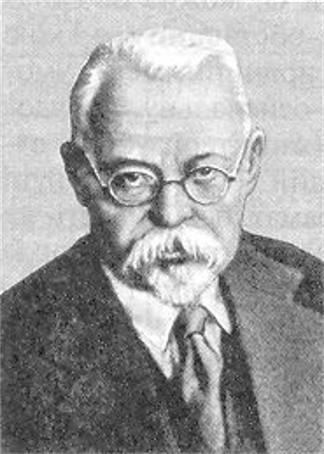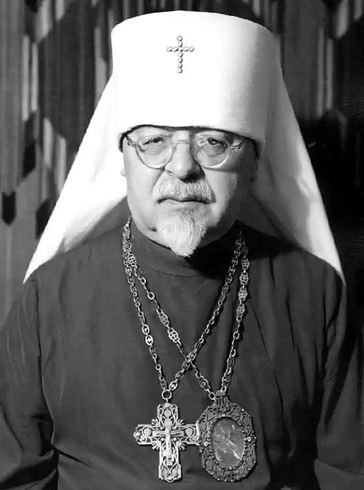Ohiienko, Ivan
Ohiienko, Ivan [Огієнко, Іван; Ohijenko] (monastic name: Іларіон [Ilarion]), b 14 January 1882 in Brusyliv, Radomyshl county, Kyiv gubernia, d 29 March 1972 in Winnipeg. Orthodox metropolitan, linguist, church historian, and cultural figure; full member of the Shevchenko Scientific Society from 1923. He studied Slavic philology and literature under Volodymyr Peretts at Kyiv University and graduated in 1909 after completing a thesis on Ioanikii Galiatovsky's Kliuch razumieniia. In 1912 he completed the Higher Pedagogical Courses and began to teach at the Kyiv Commercial Institute, and in 1915 at Kyiv University.
Following the Revolution of 1917, Ohiienko played an important role in the Ukrainization of higher education and scholarship. He became a professor of the history of Ukrainian culture at the new Ukrainian State University of Kyiv in 1918. Forced to leave the city following the Bolshevik seizure of power there, he helped organize and became the first rector of the Kamianets-Podilskyi Ukrainian State University. As a member of the Ukrainian Party of Socialists-Federalists he served as minister of education (early 1919) and then minister of religious affairs (from August 1919) in the Council of National Ministers of the Ukrainian National Republic.
With the defeat of the Ukrainian National Republic, Ohiienko settled in Tarnów (Poland) in 1920, where he participated in the Council of the Republic and resumed his functions as minister of religion in the government-in-exile of the Ukrainian National Republic (to 1924). He taught at a Lviv gymnasium (1924–6) before becoming professor of Church Slavonic and paleography at the Orthodox Faculty of Theology at Warsaw University (1926). After being removed from his post in 1932 in the anti-Ukrainian campaign initiated by the Polish authorities, he worked as a private scholar and published the journals Ridna mova and Nasha kul’tura (Warsaw). He also resumed work on the translation of the Bible into Ukrainian (which he had begun in the early 1920s). His translation of the Gospels appeared in 1937, followed by the New Testament, including the Psalms, in 1939. He finished most of the Bible in 1940 but was not able to publish it because of the war. After revisions and other changes, his complete translation appeared in 1962.
In October 1940 Ohiienko was tonsured and then consecrated bishop of Kholm and Podlachia by Metropolitan Dionisii Valedinsky of the Polish Autocephalous Orthodox church in the wartime Generalgouvernement. He began to Ukrainianize the church in the Kholm region, by introducing Ukrainian practices in the church rite and the use of Ukrainian in services and ordaining several Ukrainian priests. After being elevated to the rank of metropolitan by Valedinsky in March 1944, he was soon forced to flee the advancing Soviet Army to Austria and then Switzerland. In September 1947 he was invited to Canada by the parish of Saint Mary the Protectress in Winnipeg. In August 1951 he was elected metropolitan of Winnipeg and head of the Ukrainian Orthodox Church of Canada (UOCC). He established the theological journal Vira i kul’tura and revived Nasha kul’tura (Winnipeg), founded a theological society (now the Metropolitan Ilarion Theological Society), and lectured and served as dean of theology at Saint Andrew's College.
A prolific writer, Ohiienko published scores of monographs and articles on a variety of topics. His first major publication, ‘Ohliad ukraïns’koho iazykoznavstva’ (Survey of Ukrainian Linguistics, in Zapysky Naukovoho tovarystva im. Shevchenka, vols 79–80, 1907), was followed by several articles on Ioanikii Galiatovsky, the subject of his MA thesis. In 1918 he published Ukraïns’ka kul’tura (Ukrainian Culture). Other works in cultural history included Istoriia ukraïns’koho drukarstva (A History of Ukrainian Printing, 1925), Dokhrystyians’ki viruvannia ukraïns’koho narodu: Istorychno-relihiina monohrafiia (Pre-Christian Beliefs of the Ukrainian Nation: A Historical-Religious Monograph, 1965), Kniaz’ Kostiantyn Ostroz’kyi i ioho kul’turna pratsia (Prince Kostiantyn Ostrozky and his Cultural Work, 1958), and Fortetsia pravoslaviia na Volyni: Sviata Pochaïvs’ka Lavra (The Fortress of Orthodoxy in Volhynia: The Holy Pochaiv Monastery, 1961). In the 1920s he initiated a series of works on the history of the Slavic languages, beginning with Kostiantyn i Mefodii: ïkh zhyttia ta diial’nist’ (Constantine and Methodius: Their Lives and Activity, 2 vols, 1927–8), and continuing with monographs on the phonetics of Church Slavonic (1927), the origins of Slavic alphabets and literary languages (1928), Slavic documents of the 10th and 11th centuries (1929), and old Slavic paleography (1928). He also examined the history of Ukrainian and Russian accents (1914) and accents in historical and geographical names (1912). He devoted more attention to this problem in several articles and in many general surveys of Ukrainian linguistics and stylistics, eg, Kurs ukrainskogo iazyka (A Course in the Ukrainian Language, 1918), Ukraïns’kyi stylistychnyi slovnyk (A Ukrainian Stylistics Dictionary, 1924), Chystota i pravyl’nist’ ukraïns’koï movy (The Purity and Correctness of the Ukrainian Language, 1925), and Suchasna ukraïns’ka literaturna mova (The Contemporary Ukrainian Literary Language, 1935). A representative of the ‘ethnographic’ school in Ukrainian linguistics, he was particularly concerned with popularizing norms of literary Ukrainian and narrowing the gap between the literary and spoken language; many of his monographs were intended as textbooks, and his journal Ridna mova was almost exclusively devoted to this concern. He also made several contributions to Ukrainian etymology and lexicography, including dictionaries of little-used place-names (1934) and words (1973); Skladnia ukraïns’koï movy (A Treasury of the Ukrainian Language, 1937–8); and Etymolohichnyi-semantychnyi slovnyk ukraïns’koï movy (Etymological-Semantic Dictionary of the Ukrainian Language), three volumes of which have appeared posthumously. His translations were important in the development of modern Ukrainian religious terminology and liturgical language.
Ohiienko's most important works on the history of the Ukrainian language were Ukraïns’ka mova XVI-ho stolittia i Krekhivs’kyi apostol 1560-ykh rokiv (The Ukrainian Language of the 16th Century and the Krekhiv Apostolos of the 1560s, 1930), Narysy z istoriï ukraïns’koï movy (Surveys of the History of the Ukrainian Language, 1927), and Istoriia ukraïns’koï literaturnoï movy (History of the Ukrainian Literary Language, 1950). As a historian of the Ukrainian church, Ohiienko wrote such monographs as Kanonizatsiia sviatykh v ukraïns’kii Tserkvi (The Canonization of Saints in the Ukrainian Church, 1965), Ukraïns’ka Tserkva za Bohdana Khmel’nyts’koho, 1647–1657 (The Ukrainian Church during the Period of Bohdan Khmelnytsky, 1647–57, 1955), and Ukraïns’ka Tserkva za chas ruïny (The Ukrainian Church during the Period of the Ruin, 1956). His survey history of the Ukrainian church, originally published in 1942, appeared in English translation in 1986. A collection of his sermons appeared in 1973.
BIBLIOGRAPHY
Zaïkin, V. Profesor Ivan Ohiienko iak tserkovnyi ta hromads’kyi diiach i iak uchenyi (Warsaw 1925)
Naukovyi zbirnyk v 30 richnytsiu naukovoï pratsi prof. d-ra Ivana Ohiienka (Warsaw 1937)
Iuvileina knyha na poshanu Mytropolyta Ilariona u 75-littia ioho zhyttia i pratsi, 1882–1957 (Winnipeg 1958)
Zhalobna knyha v pam'iat’ Mytropolyta Ilariona (Winnipeg 1973)
Marushkevych, A. Nevtomnyi pratsivnyk ukraïns’koho renasansu Ivan Ohiienko: Pedahohichnyi aspekt (Kyiv 1996)
Timenyk, Z. Ivan Ohiienko (Mytropolyt Ilarion), 1882–1972: Zhyttiepysno-bibliohrafichnyi narys (Lviv 1997)
Tymoshyk, M. Holhofa Ivana Ohiienka: Ukraïnoznavchi problemy v derzhavotvorchii, naukovii, redaktors'kii ta vydavnychii diial'nosti (Kyiv 1997)
Liakhots’kyi, V. Prosvitytel’: Vydavnychno-redaktsiina diialnist’ Ivana Ohiienka (Mytropolyta Ilariona) (Kyiv 2000)
Tymoshyk, M. “Lyshus’ naviky z chuzhynoiu”: Mytropolyt Ilarion (Ivan Ohiienko) i ukraïns’ke vidrodzhennia (Kyiv 2000)
Ivan Korovytsky
[This article originally appeared in the Encyclopedia of Ukraine, vol. 3 (1993). The bibliography has been updated.]

.jpg)
.jpg)

.jpg)
